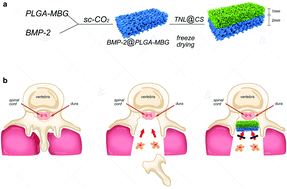A tranilast and BMP-2 based functional bilayer membrane is effective for the prevention of epidural fibrosis during spinal lamina reconstruction†
Abstract
Failed Back Surgery Syndrome (FBSS) is a common complication of lumbar surgery. There are a multitude of reasons for FBSS including both pre-operative and post-operative risk factors. Epidural fibrosis is one of the major cause of FBSS, with no effective therapeutic treatment for it. In this study, a CS/PLGA–MBG bilayer membrane loaded with tranilast (TNL) and BMP-2 was used to reconstruct the vertebral plate and the level of epidural fibrosis was assessed in the rabbit laminectomy model. Results revealed that whilst laminectomy site in control group was filled with disordered fibrous tissue that had invaded the dura mater, no fibrous tissue formation nor invasion was observed in TNL/BMP2 treated group. Furthermore, new bone formations at the laminectomy site was also observed in experimental group loaded with TNL/BMP-2. In vitro cellular and molecular studies found that TNL reduced osteogenic differentiation of murine MSC cells and fibrosis formation by downregulating p65 phosphorylation and nuclear translocation thereby inhibiting NF-κB signaling. Collectively, these findings suggested that tranilast@CS/BMP-2@PLGA–MBG bilayer membrane exhibit clinical potential in the prevention of FBSS.



 Please wait while we load your content...
Please wait while we load your content...